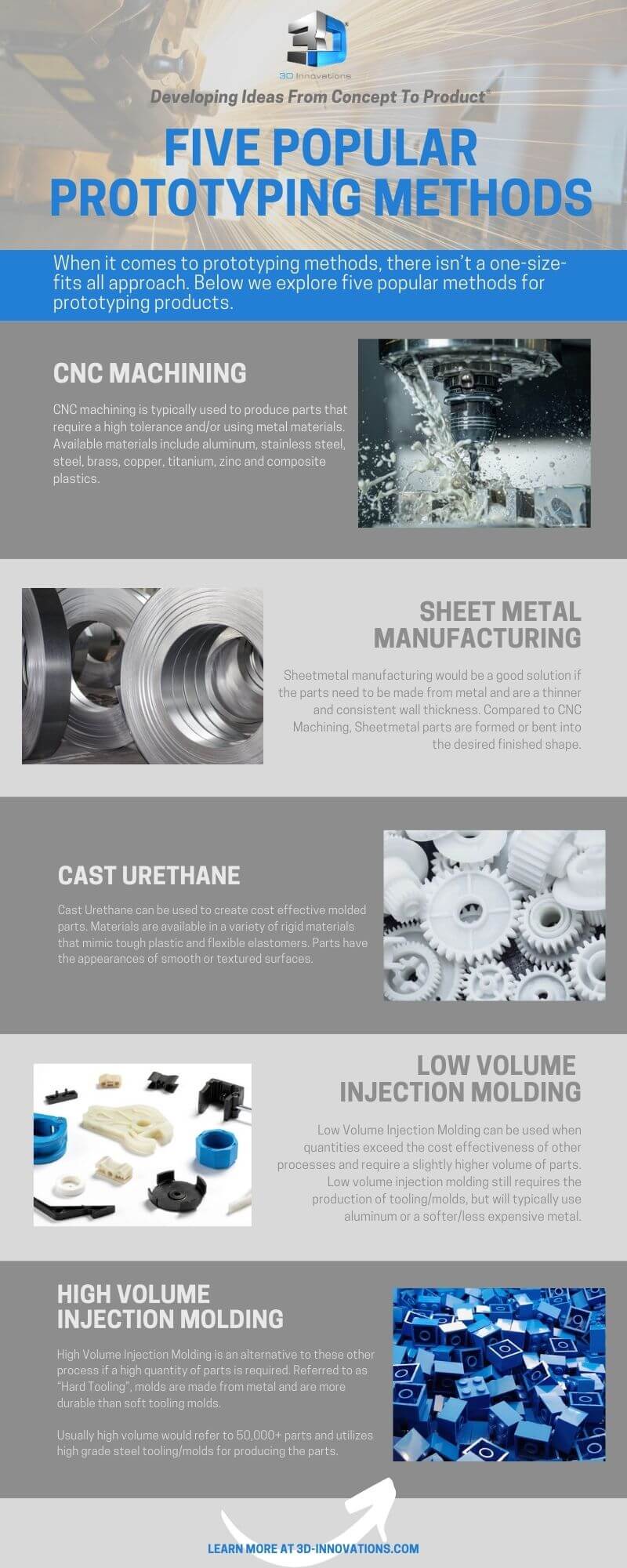 When it comes to prototyping methods, there isn’t a one-size-fits all approach. Instead, there are a range of options based on a number of design and manufacturing factors. The best prototyping method for you will ultimately depend on your product complexity, material selection and the quantity required.
When it comes to prototyping methods, there isn’t a one-size-fits all approach. Instead, there are a range of options based on a number of design and manufacturing factors. The best prototyping method for you will ultimately depend on your product complexity, material selection and the quantity required.
Below we dive into five popular prototyping methods, the benefits of each and material options.
CNC Machining
CNC machining is typically used to produce parts that require a high tolerance and/or using metal materials. Available materials include aluminum, stainless steel, steel, brass, copper, titanium, zinc and composite plastics.
Metallic parts can be further finished using post processing methods such as bead blasting to create a smooth matte appearance, coatings such as anodizing, passivating, powder coating, and plating for corrosion resistance.
Sheet Metal Manufacturing
Sheet metal manufacturing would be a good solution if the parts need to be made from metal and are a thinner and consistent wall thickness. Compared to CNC Machining, Sheet metal parts are formed or bent into the desired finished shape.
Features are typically cut out of the sheet using CNC Machining, Laser Cutting, or Waterjet cutting methods prior to bending/forming. Standard materials are aluminum, stainless steel, steel, and other alloys. Parts can be welded together if required.
Cast Urethane
Cast Urethane can be used to create cost effective molded parts. Materials are available in a variety of rigid materials that mimic tough plastic and flexible elastomers. Parts have the appearances of smooth or textured surfaces. Some applications for this process are to produce parts or assemblies for low volume production, advanced prototyping for functional testing, and for early market evaluation or launching.
Often referred to as “Soft Tooling”, Cast urethane typically utilizes 3D Printed parts to create the master pattern and liquid silicone to create the molds. The use of soft tooling (silicone) molds are less expensive than production molds to produce initial products without the high cost of market entry. Some other advantages are the quick production lead time compared to injection molding and requires less upfront investment.
Low Volume Injection Molding
Low Volume Injection Molding can be used when quantities exceed the cost effectiveness of other processes and require a slightly higher volume of parts. Low volume injection molding still requires the production of tooling/molds but will typically use aluminum or a softer/less expensive metal. Costs for molds will likely be less than a full production mold but, will also yield a lower lifecycle quantity which is why it makes for a good solution if you require a lower quantity.
Typical materials are ABS, ASA, Nylon, HDPE, LDPE, and Polycarbonate. Rubber or rubber like materials are also available with this process and include EPDM, PVC, TPE, TPU, and silicone.
High Volume Injection Molding
High Volume Injection Molding is an alternative to these other processes if a high quantity of parts is required. Referred to as “Hard Tooling”, molds are made from metal and are more durable than soft tooling molds.
Typically, high volume would refer to 50,000+ parts and utilizes high grade steel tooling/molds for producing the parts. Lifecycles of these molds can exceed 500,000 shots per mold before the mold would need to be refurbished. Typical materials are ABS, ASA, Nylon, HDPE, LDPE, and Polycarbonate. Rubber or rubber like materials are also available with this process and include EPDM, PVC, TPE, TPU, and silicone.
As you can see, prototyping methods vary greatly based on a number of factors. Finding the right method early-on will benefit you in the prototyping stage of development but also further on in the product development timeline as well.
Have questions about prototyping methods? Send us an email at info@3d-innovations.com
Popular Prototyping Methods Infographic:

_____
3D Innovations is a Product Development Company – from the 3D Design to a fully functional 3D Prototype & Product.
Subscribe to the 3D Innovations newsletter on our Facebook page!

